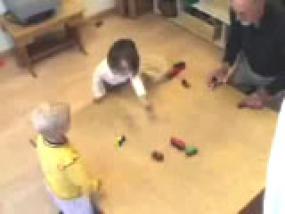Emphasizing Effects

A boy (in yellow) and a girl (in white), each two years of age, are playing with small toy cars on a raised platform. George, a visiting adult, enters the game. During this episode, George looks for opportunities to increase the complexity of the children’s play. He is careful not to voice the details of his own actions, but instead describes only the effects, e.g. "That time they did not spin around." Highlighting these visible effects causes the children to invent their own strategies to recreate the effects themselves.
[flv]Click here to watch[/flv] how the children not only recreate the effects that they see, but also how they embellish them with interesting complexity. For example, the boy discovers that he can push two little cars at once, then three, then four. The resulting rolls create parallel movements that bump and branch in a delightful display.
By the end of the episode, the children’s play with cars becomes more purposive and interactive. George steps aside. We see how the game’s rules and customs develop, and how the shape of the game changes from parallel-play (with both children rolling cars at once) to differentiated and collaborative roles (one child rolls three cars at a time; the other child catches and puts them in a basket). These seven minutes of play demonstrate how children can work from goals to strategies, which places them in the role of inventor as opposed to passive student.
Keywords: Twos, Toy Cars, Teaching, Children-Teacher, Cause/Effect, Force, Game Rules, videative
Length of videative: 5 text pages, 11 video subclips
Length of stand-alone master video clip: 6 minutes, 55 seconds
